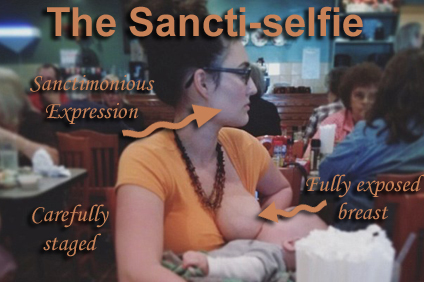They say a picture is worth a thousand words. That’s why sancti-selfies have become the latest weapon in the mommy wars.
Several weeks ago I wrote about brelfies, breastfeeding selfies. I quoted the paper Selfies| Virtual Lactivism: Breastfeeding Selfies and the Performance of Motherhood by Boon and Pentney.
[pullquote align=”right” color=”#c78157″]The sancti-selfie says: I am a better mother than you![/pullquote]
Situated between lactivism and narcissism, the breastfeeding selfie must … be understood as both a personal gesture and a political act…
Like other selfies, breastfeeding selfies offer individuals the possibility of microcelebrity, the opportunity to present carefully manufactured and managed online selves across a range of social media platforms, with the “audience” imagined as fans…
If … participation in social media is modeled on corporate branding strategies, particularly active self-promotion and status-seeking behavior, then the selfie may be the most obvious example of the self as brand commodity.
Brelfies are a subset of what I call “sancti-selfies.”
What are sancti-selfies?
Situated between sanctimony and narcissism, the sancti-selfie is both a personal gesture and a political act. It conveys a dual message:
Look at me! I’m an awesome mother!
and:
If you aren’t mirroring my own choices back to me, I am a better mother than you.
In other words, they’re just the latest sanctimommy tool for compelling ideological adherence.
In my experience, most sancti-selfies are posted by breastfeeding and homebirth advocates. The sancti-selfie above, taken by Ashley Kaidel, is a perfect example.
Carefully staged tableau? Check!
Breast exposed far more than needed to feed a baby? Check!
Sanctimonious expression? Check!
Many, many women breastfeed. Very few feel compelled to photograph themselves doing so and even fewer feel the need to post those photos on social media. But among lactivists and homebirth advocates, sancti-selfies are practically de rigeur.
Think about it. How many women post photos of themselves feeding their infants on social media? Very few and nearly all of them are breastfeeders. How many women feel compelled to post photos and videos of a baby emerging from their vagina. Very few and nearly all are homebirth advocates. A baby born vaginally in a hospital emerges in exactly the same way, yet women who have epidurals don’t feel the need to display it on Twitter.
That’s why, as Boon and Pentney note, brelfies are posted almost exclusively privileged women:
Perhaps not surprisingly, then, the vast majority of breastfeeding selfies posted … feature white mothers and children and reference cisgender, heterosexual family structures. While most images do not include the full body, the bodies that are shown appear to align with standard body ideals; for example, there are no visibly fat bodies included.
What’s that I hear you say? They’re normalizing breastfeeding and vaginal birth?
Are we really supposed to be gullible enough to believe that?
When lactivists promote normalizing breastfeeding they are using “normal” to signify normative and morally preferable. When homebirth advocates display babies dangling from vaginas they are using “normal” to signify that unmedicated vaginal birth is normative and morally preferable.
Birth and breastfeeding advocates are aware that describing breastfeeding and childbirth in these ways is vicious, creating two classes of mothers, good mothers and bad mothers. That’s the point point of sancti-selfies, to be sanctimonious.
They want to behave viciously but they don’t want to be accused of doing so. They claim they are “normalizing” breastfeeding and vaginal birth in order to create plausible deniability. No, no, no, they’re not trying to shame formula feeding mothers, they’re simply pointing out that breastfeeding is the normal and natural way to feed an infant. No, no, no, they don’t mean that normal birth is better; they just mean that it is the common way to give birth.
We should recognize sancti-selfies for what they are: portraits of the ugly marriage of narcissism and sanctimony that characterizes so much of lactivism and homebirth (as well as natural childbirth) advocacy.
And we shouldn’t let them get away with it.


